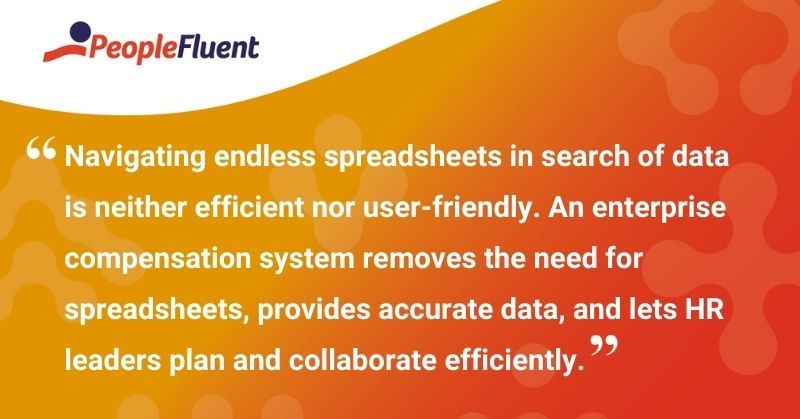Published: Jul 30, 2021Time to read: 5mins Category: Compensation
5 Benefits and Must-Have Features of a Compensation Solution
Compensation can account for anywhere between 20-50% of your operating budget, so it’s important to get it right. However, you may be questioning if you really need a compensation management solution or if you can just use spreadsheets. We strongly caution against this manual method: human error is inevitable (and costly when it happens). Plus, automating the process can help companies in many ways—keep reading for the benefits and must-have features of a compensation solution.
Compensation management may be the most critical HR function of all. It affects operating budgets, employee engagement, recruiting, retention, performance, and productivity. When done right, rewarding and incentivizing employees can have lasting benefits for your organization, such as:
- Helping you attract high-quality candidates
- Improving your organization’s retention rates
- Positively impacting business results.
If you want to reap the rewards of a great compensation strategy, you need the right tools. Throughout the article, you’ll find the top benefits and features that a compensation solution should offer.
1) Managing Complex Processes and Calculations
Without the right tools, managing complex processes and calculations can be challenging; even for the savviest compensation pros. From a legal and ethical standpoint, organizations need to ensure they are paying fairly—regardless of ethnicity, gender, or position. Linking salary to objective factors (e.g. employee skills, job duties, geography, and market conditions) can be a tough task. A compensation solution can perform these calculations across all of your unique rewards programs.

KEEP READING | ‘Workplaces That Work: How to Create a Culture That Embraces Pay Equity’
2) Change Management and Decision Support
Management decisions drive the creation of a more efficient compensation strategy. The right solution will reinforce your strategy by reducing subjective decisions with embedded business intelligence, video coaching, and detailed analytics. It will also educate managers with just-in-time learning content—making sure they have the skills, data, and analytics to make informed decisions.
Developing these methods will give your managers the resources they need to be more agile and effective as decision-makers. This empowerment is key for productive teams across the business—highlighting how compensation influences the overall employee experience.
3) Fast and Efficient Planning
Navigating endless spreadsheets in search of data is neither efficient nor user-friendly. One of the most common complaints from HR leaders is that they have to rely on spreadsheets for some or all of their compensation planning. An enterprise compensation system removes the need for spreadsheets, provides accurate data, and lets HR leaders plan and collaborate efficiently.

RELATED READING | ‘3 Ways to Innovate and Improve Your Compensation Design Process’
4) Flexible Data Import and Export
Even if your compensation management system supports comprehensive planning within the application, we know you may still want data exported into spreadsheets. The ideal solution will easily export and re-import data for aggregation into the system.
5) Fully Integrated Data
With a robust compensation solution, all the data points that relate to an employee’s compensation live in one place. Not only does this improve accuracy and consistency across the pay process, it also helps leaders improve communication and transparency. For most organizations, managers make compensation decisions for their employees. How do you engage and educate managers on your compensation strategy? One way to do so is with data and analytics to help them inform those decisions. This also gives leaders a way to track management decisions and ensure they work within your strategy.
YOU MIGHT ALSO LIKE | ‘3 Benefits of Setting up a Compensation Team’
Get Started By Building the Right Team
Because compensation affects every department, it’s important to establish cross-functional participation and support before making any changes. This allows stakeholders to feel heard and included, share vital information, and help to select a vendor from the beginning. The team should start by organizing critical information around compensation:
- Identifying key stakeholders including an executive sponsor, managers, IT, finance, and of course, the compensation team.
- Gather feedback from key stakeholders on how the compensation processes and communication can be improved.
- Defining systems with which the compensation system has to play nicely.
- Describing current processes and gathering relevant documentation, including plan definitions, planning spreadsheets, as well as statements and communications.
Choose a point person to coordinate the committee’s activity and keep an eye on all aspects of the selection process. Seek out stakeholders who will provide thoughtful and thorough input and participate fully in the process.

RELATED RESOURCE TO DOWNLOAD | ‘Compensation Management: 8 Factors for Comparing Common Tools’
Finally, ask a member from your executive team to be a sponsor—if the project was not initiated by someone in this position). Without someone in a senior role to spearhead and champion the process, the selection committee may find it tough to juggle conflicting inputs from stakeholders.
As early as possible, your selection team should conduct a kick-off meeting and agree on a project plan. The written plan should include due dates and clear definitions of individual responsibilities.
The Bottom Line
The choice to switch from spreadsheets to an automated compensation tool can be daunting. You may not be sure where to get started, or, you might be concerned about company buy-in. Doing your research (both for vendors and on company needs) and putting a plan together will help.
With the right tech, and a solid plan on how you'll use it to manage compensation, you can reward your top talent and remain competitive.
Ready to Enhance Your Compensation Management Strategy?
To learn more about how PeopleFluent’s compensation management solution can help you foster greater efficiencies at your organization, download a copy of 'The Ultimate Buyers' Guide for Compensation Management'.